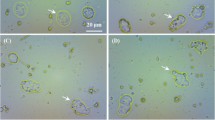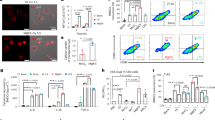Abstract
WORKERS studying the phagocytic activity of tumour cells seem to prefer in vitro systems1,2. Little work appears to have been done on the ability of tumour cells to take up colloidal or particulate substances in vivo. Because of the possible practical importance of the subject, it was decided to study the reticulo-endothelial activity of mouse tumours. Acetone-killed, radioiodinated Brucella abortus (131IBr) were chosen as the test particle, since previous work3 had shown that these bacteria are a very sensitive indicator of phagocytic activity.
This is a preview of subscription content, access via your institution
Access options
Subscribe to this journal
Receive 51 print issues and online access
$199.00 per year
only $3.90 per issue
Buy this article
- Purchase on Springer Link
- Instant access to full article PDF
Prices may be subject to local taxes which are calculated during checkout
Similar content being viewed by others
References
Gropp, A., and Hupe, Kl., Z. Krebsforschung, 61, 263 (1956).
Shepard, C. C., Fed. Proc., 17, 534 (1958).
Sulitzeanu, D., Bdolach, A., and Sperling, O., J. Immunol., 84, 551 (1960).
Sulitzeanu, D., J. Immunol., 82, 304 (1959).
Author information
Authors and Affiliations
Rights and permissions
About this article
Cite this article
SULITZEANU, D. Localization of Radioactivity in Tumours of Mice injected intravenously with Killed, Radioiodinated Brucella abortus . Nature 188, 757–758 (1960). https://doi.org/10.1038/188757a0
Issue Date:
DOI: https://doi.org/10.1038/188757a0
Comments
By submitting a comment you agree to abide by our Terms and Community Guidelines. If you find something abusive or that does not comply with our terms or guidelines please flag it as inappropriate.



